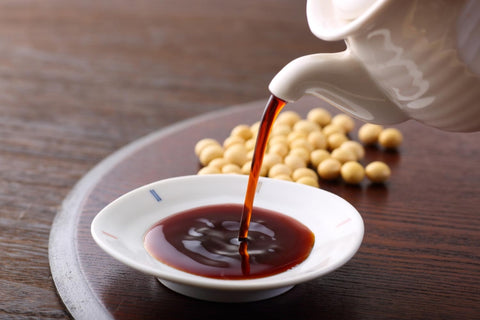4 things to know about Japanese soy sauce
Soy sauce must have been a familiar dipping sauce for Vietnamese people. But did you know that for each country, the taste of soy sauce brings a different experience. Japanese soy sauce is also known as one of the long-established and unique culinary cultures. Find out with Kosei right here!
Origin of Japanese soy sauce
Soy sauce in Japanese is called Shoyu (Sho is the word for "soy sauce" 醤 means soy sauce, yu 油 is the word "du" meaning "oil, cooking oil"), which literally means fermented edible oil. During the Nara period, the forerunner of Shoyu appeared under the name Hishio, which was produced by fermenting a mixture of rice, meat, fish, vegetables and seaweed. Later, it was transformed into two different sauces, Shoyu and Miso. Some dipping sauces such as Tamari, Koikuchi, and Usuguchi are also derived from Hishio and are widely used. By the end of the sixteenth century, the delicious Japanese soy sauce Shoyu had become popular in every meal in Japanese families.

Currently, Japanese Shoyu soy sauce is made from a mixture of soybeans, wheat, salt, and yeast. The application of machine technology to the production process helps the soy sauce making process to take place faster and more conveniently, greatly supporting the increasing demand of domestic people and also supplying to oversea consumers.
The characteristics and effects of Japanese soy sauce
Featured
Traditional Japanese soy sauce is usually brown in color with 3 basic flavors: dark, light, vegan, of which 4/5 of the production is in the bold type. Compared to the soy sauce of many other countries, such as China, there are still many differences. Chinese soy sauce uses mostly soybeans and only a few roasted grains, while in Japan, half of the wheat is used, so it has a sweeter taste, of course, you can't use these two instead. mutual position.

The effect of Japanese soy sauce brings
Soy sauce is used a lot in meals in Japan with the use of accompanying dishes, helping to increase the delicious taste. In addition, it can be used to season and reduce the fishy smell of meat and fish. Using Japanese soy sauce in combination with other spices can create a variety of special sauces, suitable for different dishes.
Famous Japanese soy sauces you need to know
Soy sauce with wasabi
Shoyu soy sauce when used in combination with Wasabi mustard helps to add flavor to the dish, especially suitable when used with dipping foods such as sushi, sashimi, seafood, beefsteak...

Soy sauce used to eat eggs
Also made from the same ingredients as the special soy sauce used to eat with tofu, this soy sauce also helps bring out a sweet aftertaste that is especially suitable for egg dishes.

Sashimi sauce
In addition to using traditional Shoyu soy sauce ingredients, sashimi soy sauce is combined with other spices such as salt and sugar to help users feel more delicious when used with sashimi dishes.

Traditional Japanese Shoyu Soy Sauce
Traditional Japanese Shoyu soy sauce is used a lot for dipping with a variety of dishes, in addition, it can be used for seasoning and cooking very effectively. Depending on the type of Shoyu selected, it can bring different flavors but basically include: bold, light and vegan.

Specialized soy sauce to eat with tofu

Is a soy sauce that combines traditional Japanese Shoyu soy sauce with Dashi broth from grated tuna and sardines, helping to add a delicious and sweet taste after using it with dishes made from tofu. Besides, it can be used for seasoning and cooking.
